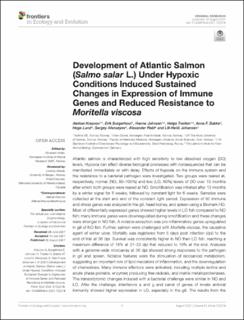Development of Atlantic Salmon (Salmo salar L.) Under Hypoxic Conditions Induced Sustained Changes in Expression of Immune Genes and Reduced Resistance to Moritella viscosa
Krasnov, Aleksei; Burgerhout, Erik; Johnsen, Hanne; Tveiten, Helge; Bakke, Anne Flore; Lund, Hege; Afanasyev, Sergey; Rebl, Alexander; Johansen, Lill-Heidi
Peer reviewed, Journal article
Published version
Permanent lenke
https://hdl.handle.net/11250/2775085Utgivelsesdato
2021Metadata
Vis full innførselSamlinger
- Artikler / Articles [1456]
- Publikasjoner fra CRIStin [2533]
Sammendrag
Atlantic salmon is characterized with high sensitivity to low dissolved oxygen (DO) levels. Hypoxia can affect diverse biological processes with consequences that can be manifested immediately or with delay. Effects of hypoxia on the immune system and the resistance to a bacterial pathogen were investigated. Two groups were reared at, respectively, normal (NO, 80–100%) and low (LO, 60%) levels of DO over 10 months after which both groups were reared at NO. Smoltification was initiated after 13 months by a winter signal for 6 weeks, followed by constant light for 6 weeks. Samples were collected at the start and end of the constant light period. Expression of 92 immune and stress genes was analyzed in the gill, head kidney, and spleen using a Biomark HD. Most of differentially expressed genes showed higher levels in LO fish compared to NO fish; many immune genes were downregulated during smoltification and these changes were stronger in NO fish. A notable exception was pro-inflammatory genes upregulated in gill of NO fish. Further, salmon were challenged with Moritella viscosa, the causative agent of winter ulcer. Mortality was registered from 5 days post infection (dpi) to the end of trial at 36 dpi. Survival was consistently higher in NO than LO fish, reaching a maximum difference of 18% at 21–23 dpi that reduced to 10% at the end. Analyses with a genome-wide microarray at 36 dpi showed strong responses to the pathogen in gill and spleen. Notable features were the stimulation of eicosanoid metabolism, suggesting an important role of lipid mediators of inflammation, and the downregulation of chemokines. Many immune effectors were activated, including multiple lectins and acute phase proteins, enzymes producing free radicals, and matrix metalloproteinases. The transcriptomic changes induced with a bacterial challenge were similar in NO and LO. After the challenge, interferons a and g and panel of genes of innate antiviral immunity showed higher expression in LO, especially in the gill. The results from the present study suggest that chronic hypoxia in early life stimulated immune genes and attenuated their downregulation associated with smoltification. However, these changes did not improve protection against a bacterial pathogen of major concern in salmon aquaculture.
